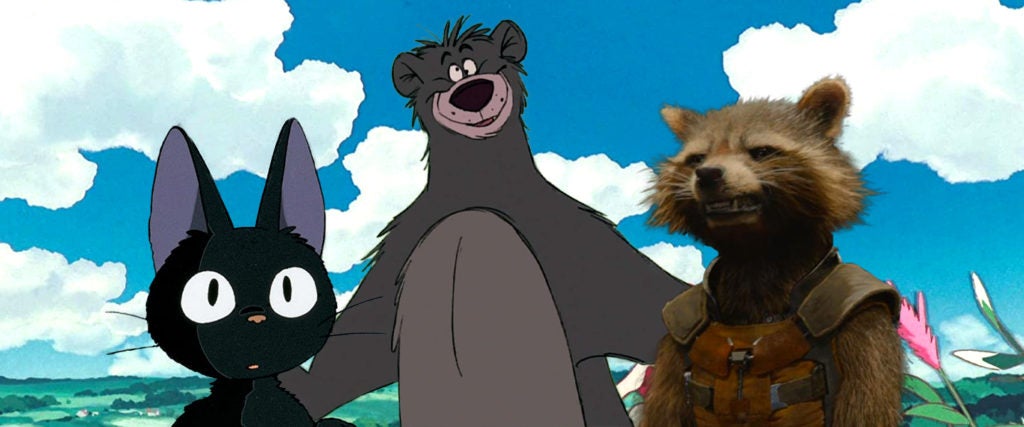In 1937, writer Walter R. Brooks penned a short story called “The Talking Horse,” about a chatty palomino named Ed. The piece spawned a whole string of sequel stories in the 1930s and 1940s, until eventually the sitcom Mister Ed debuted in the 1960s, becoming the rare TV series that was so popular in syndication that it was picked up by a major network. Meanwhile, the success of Brooks’ original Ed saga helped Army vet David Stern III sell his own tales of a talking mule named Francis — a character which starred in a slew of 1950s movies.
Ed and Francis were pioneers of an eclectic, surprisingly fertile sub-genre. Since their screen debuts, we’ve seen countless movies and TV shows where animals talk to humans — sometimes serving as companions, sometimes advisors and sometimes nuisances. But which of these critters actually has something worthwhile to say?
The list below represents the general continuum of talking animals, from the lovable to the irritating. To keep the slate of candidates manageable, we’ve stuck with movie characters (though one of the below is from a short cartoon that played in theaters in the 1950s, and several appeared first in comic books, novels and TV series). Also, to be eligible, the animals in question had to talk to at least one human person, and not just other animals. The rats from Ratatouille and the lions from The Lion King, as well as the hairy star of the newly-released The One and Only Ivan, for example, didn’t make that cut.
With all of that in mind, let’s get to the speculating. Which of these famous talking animals might actually be a decent conversationalist?
Baloo
What’s the Deal?: In both the 1967 and the 2016 Disney movie versions of author Rudyard Kipling’s classic adventure anthology The Jungle Book, Baloo the bear serves as the happy-go-lucky counterpoint to the much sterner Bagheera the panther, as they each try to instruct the “man-cub” Mowgli on the ways of the wild.
Good Company?: Baloo may not be that good for Mowgli’s maturation process, given that he mostly teaches the boy how to laze around all day, doing as little as possible. But is he a joy to be around? Absolutely. The only question we have here is which Baloo is better: the boisterous hipster voiced by Phil Harris in 1967, or the cynical sleepyhead voiced by Bill Murray in 2016? You decide.
Rocket Raccoon
What’s the Deal?: Sprung from the pages of Marvel comics, the furry, gun-slinging space alien known as Rocket has appeared on the big screen in both Guardians of the Galaxy movies as well as Avengers: Endgame, voiced in all cases by Bradley Cooper. He’s small but powerful and he hates being called a “raccoon.”
Good Company?: Irascible though he is, Rocket would absolutely be a blast to hang out with. He’s got a good sense of humor, and he could surely spin stories for days about his intergalactic adventures. He also seems like a loyal, tender-hearted friend, always available in good times and bad.
Stuart Little
What’s the Deal?: In the original 1945 E.B. White novel, Stuart Little is actually a human child who just happens to look like a two-inch-high mouse (which… eesh). In the 1999 movie version though, Stuart’s a straight-up mouse, who just happens to wear human clothes and talk (and in the voice of Michael J. Fox, no less).
Good Company?: Who doesn’t love Stuart Little? Sure, he’s a bit of a goody-goody, but like Paddington Bear (another excellent talking animal), he’s ultimately as plucky as he is pleasant.
Prince Naveen
What’s the Deal?: Better known as “the Frog” in the sweetly old-fashioned Disney animated movie The Princess and the Frog, Prince Naveen is technically a human, who gets turned into a frog courtesy of a voodoo curse. And since we’re being totally honest, we should also point out that the human this frog talks to — a 1920s New Orleans chef-in-training named Tiana — becomes a frog herself, not long after kissing Naveen. In fact, this whole film is a wonderful subversion of Disney’s usual “talking animal” sidekick trope.
Good Company?: So long as you can handle this lothario’s attempts to seduce you, Naveen is a kick. He’s one charming, fun-loving amphibian.
Spider-Ham
What’s the Deal?: Another weird Marvel character, “Peter Porker, the Spectacular Spider-Ham” began life as a one-off gag in a comic book (as a knowing parody of the whole Spider-Man mythos), before getting his own regular series. He eventually appeared in the wonderfully clever 2018 animated movie Spider-Man: Into the Spider-Verse, in which multiple alternate reality versions of the web-slinger join forces.
Good Company?: In the film version at least, as voiced by comedian John Mulaney (and featuring a lot of his dry wit), he’s an absolute delight. It’s possible that his absurdist reality would become exhausting quickly, but he’s definitely someone you’d want to go out on the town with your crew, making the occasionally wry remark.
Jiji
What’s the Deal?: There’s a long tradition in stories about witches and witchcraft of animal characters that are “familiars,” serving as assistants and/or companions to practitioners of magic — and talking a lot while they’re lending a paw or claw. In Hayao Miyazaki’s 1989 animated classic Kiki’s Delivery Service (based on an Eiko Kadono novel), a teenaged witchcraft trainee gets occasional help from a wide-eyed black feline named Jiji.
Good Company?: What’s great about Jiji is that he is, ultimately, a cat, which means that while he’s a friend, he also has his own life and opinions. In the Japanese audio track of Kiki, Jiji is meeker, while in the American version he’s sassier. Each has its appeal; it’s really a matter of what you prefer.
Jiminy Cricket
What’s the Deal?: Another of Disney’s many, many talking animal sidekicks, this forefather of the likes of Archimedes, Sebastian, Iago, Mushu and Terk (among others) is one wise cricket, who serves as the “conscience” to Pinocchio, a wooden puppet who becomes a real boy.
Good Company?: Well, it depends. Jiminy can get pretty preachy, but in his appearances outside the original Pinocchio movie, he alternates his stern safety warnings with genuinely helpful educational discourse. This bug is a fount of information.
Aslan
What’s the Deal?: Created by the author C.S. Lewis, the wise, noble, self-sacrificing lion Aslan lives in an ethereal nether-kingdom where lots of other animals talk, too. In the 2005 film version of Lewis’ first published “Narnia” book, The Lion, the Witch and the Wardrobe, Liam Neeson voices the regal beast, which makes him seem all the more majestic.
Good Company?: Can you really have a casual chat with someone whom Lewis intended to be the talking animal equivalent of Jesus Christ? He’d surely have a lot to say, but he’d also be awfully intimidating.
Scooby-Doo
What’s the Deal?: Though the mystery-solving Great Dane known as Scooby-Doo made his television debut in 1969, he didn’t get his own big-time Hollywood movie until 2002, when a CGI version of Scoob (voiced by Neil Fanning) joined a fine cast of young live-action actors for a tongue-in-cheek adventure that references classic cartoon lore.
Good Company?: So-so. Although he likes chilling with his buddy Shaggy and scarfing down snacks more than he likes trouble, this classic British comedy sketch makes some good points as to why he’s not an ideal party guest:
Michigan J. Frog
What’s the Deal?: Before he became the mascot for The WB Television Network, the singing and dancing Michigan J. Frog starred in one all-time classic Merrie Melodies cartoon, written by Michael Maltese and directed by Chuck Jones. In 1955’s “One Froggy Evening,” the little croaker belts out classic vaudeville numbers with gusto, convincing the construction worker who discovers him that this frog’s about to become a superstar on the stage. The twist? Whenever the construction worker tries to show off his “client,” he reverts to acting like, well, a frog.
Good Company?: As long as no one else is around — and as long as you like old show-tunes — sure! I mean, how can you say no to the critter who inspired this?
Howard the Duck
What’s the Deal?: Generally regarded as one of the biggest bombs of the 1980s, the movie version of the 1970s Marvel Comics sensation Howard the Duck — produced by the previously unstoppable George Lucas and written and directed by his Star Wars and Indiana Jones collaborators Gloria Katz and Willard Huyck — tells the story of a duck-shaped space alien who’s been unwittingly transported to Cleveland, where he befriends a sexy young rock ’n’ roller.
Good Company?: Even in the original comic book version, Howard is grumpy and misanthropic. But at least he’s funny. The movie Howard is meant to be cuter (and perhaps more merchandise-friendly), but as a result, he has much less personality.
Jake
What’s the Deal?: Another alien in animal form (the third on this list!), “Jake” is the cute kitty from the genially inoffensive but mostly tedious 1978 live-action Disney comedy The Cat from Outer Space. Unlike some of the other beasties here, Jake (real name “Zunar-J-5/9 Doric-4-7”) “speaks” telepathically, using a special collar that also heightens his abilities to move objects with his tiny extraterrestrial mind.
Good Company?: Honestly, The Cat from Outer Space is more about the humans the cat encounters (played by such familiar TV stars as Ken Berry, McLean Stevenson and Harry Morgan), while Jake himself is more of a creature on a mission, single-minded and consequently a little dull. You’d want him on your side if you were in serious trouble, but you wouldn’t necessarily want to split a saucer of milk together afterward.
Duffy
What’s the Deal?: There’s an unsettling level of desperation just in the number of punctuation marks in the title of the 2013 family comedy A Talking Cat!?!, which features a sage, scruffy stray (voiced, inexplicably, by weathered character actor Eric Roberts, who’s not so much half-assing it here as quarter-assing it), who dispenses pedestrian advice to a dysfunctional suburban family.
Good Company?: Uh, no. Duffy certainly thinks he’s brightening the lives of the humans he meets, but really he’s kind of obtrusive and obvious. He’s like the house-pet equivalent of a Twitter “reply guy.”
Alvin
What’s the Deal?: In 1958, the songwriter and novelty record producer Ross Bagdasarian figured out that he could manipulate the speed of audio tape to create wacky characters with high-pitched voices. The success of his first single as the trio “The Chipmunks” eventually spawned an animated series and multiple movies, all featuring the two supporting Chipmunks — Simon and Theodore — led by the cocky, mischievous Alvin.
Good Company?: Well, he persistently disobeys his manager and gets into trouble, in ways far more exasperating than adorable. On the other hand he… sings okay? Yeah, Alvin sucks.

